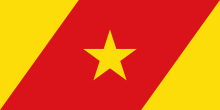Soqota (woreda)
Sekota Zuria (Amharic ሰቆጣ ዙሪያ "Greater Sekota Area") is one of the woredas in the Amhara Region of Ethiopia. Located in the Wag Hemra Zone, Sekota is bordered on the south by Gazbibla, on the southwest by Dehana, on the west by Zikuala, on the north by Abergele, and on the east by the Tigray Region. The separate woreda of town of Soqota is surrounded by Sekota. Abergele woreda was separated from Sekota.
Sekota Zuria ሰቆጣ ዙሪያ | |
|---|---|
Woreda | |
 Flag | |
| Zone | Wag Hemra |
| Region | Amhara Region |
| Area | |
| • Total | 1,722.43 km2 (665.03 sq mi) |
| Population (2007 est.) | |
| • Total | 134,702 |
The predominantly hilly terrain of the woreda serves to isolate the inhabitants of Sekota, and their steep slopes are highly degraded limiting crops yields. Crops and animal husbandry are practiced together by local farmers.[2] High points include Mount Biala (3,810 meters).
Demographics
Based on the 2007 national census conducted by the Central Statistical Agency of Ethiopia (CSA), this woreda has a total population of 112,396 of whom 56,245 are men and 56,151 women, no urban inhabitants were reported. With an area of 1,722.43 square kilometers, Sekota has a population density of 65.25, which is greater than the Zone average of 47.15 persons per square kilometer. A total of 26,903 households were counted in this woreda, resulting in an average of 4.18 persons to a household, and 25,941 housing units. The majority of the inhabitants practiced Ethiopian Orthodox Christianity, with 99.82% reporting that as their religion.[3]
The 1994 national census reported a total population for this woreda of 130,229 in 31,606 households, of whom 65,253 were men and 64,976 were women; 8,878 or 6.82% of its population were urban dwellers. The three largest ethnic groups reported in Sekota were the Agaw/Kamyr (74.24%), the Amhara (22.57%), and the Tigrayan (3.06%); all other ethnic groups made up 0.19% of the population. Kamyr was spoken as a first language by 68.67%, 26.72% Amharic, and Tigrinya was spoken by 4.56%; the remaining 0.05% spoke all other primary languages reported. The majority of the inhabitants practiced Ethiopian Orthodox Christianity, with 99.34% reporting that as their religion.[4]
Notes
- Geohive: Ethiopia Archived 2012-08-05 at the Wayback Machine
- "AMAREW 2005 extension plan", pp. 2f (accessed 15 April 2009)
- Census 2007 Tables: Amhara Region, Tables 2.1, 2.4, 2.5, 3.1, 3.2 and 3.4.
- 1994 Population and Housing Census of Ethiopia: Results for Amhara Region, Vol. 1, part 1, Tables 2.1, 2.7, 2.10, 2.13, 2.17, Annex II.2 (accessed 9 April 2009)